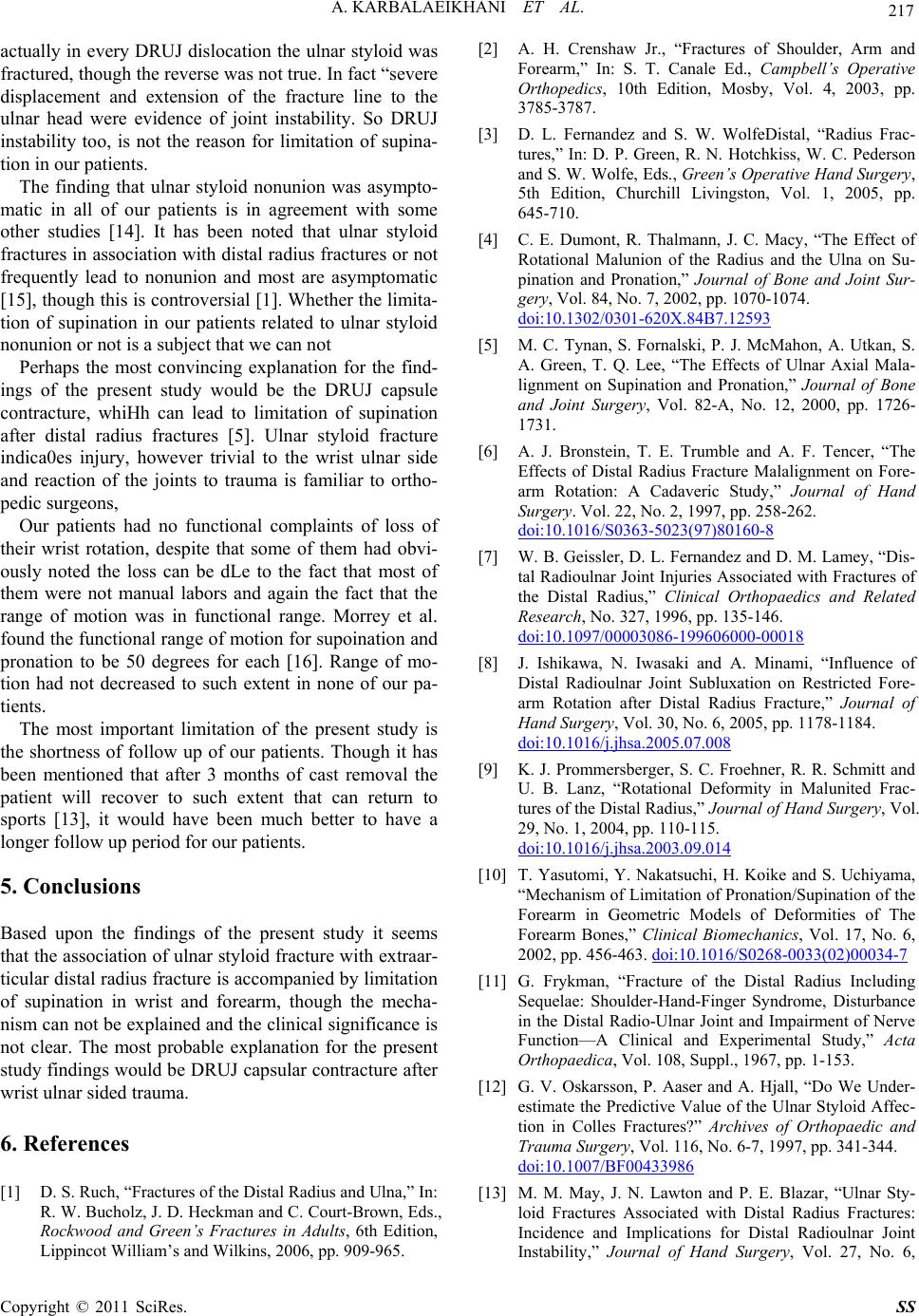
A. KARBALAEIKHANI ET AL.
217
actually in every DRUJ dislocation the ulnar styloid was
fractured, though the reverse was not true. In fact “severe
displacement and extension of the fracture line to the
ulnar head were evidence of joint instability. So DRUJ
instability too, is not the reason for limitation of supina-
tion in our patients.
The finding that ulnar styloid nonunion was asympto-
matic in all of our patients is in agreement with some
other studies [14]. It has been noted that ulnar styloid
fractures in association with distal radius fractures or not
frequently lead to nonunion and most are asymptomatic
[15], though this is controversial [1]. Whether the li mita-
tion of supination in our patients related to ulnar styloid
nonunion or not is a subject that we can not
Perhaps the most convincing explanation for the find-
ings of the present study would be the DRUJ capsule
contracture, whiHh can lead to limitation of supination
after distal radius fractures [5]. Ulnar styloid fracture
indica0es injury, however trivial to the wrist ulnar side
and reaction of the joints to trauma is familiar to ortho-
pedic surgeons,
Our patients had no functional complaints of loss of
their wrist rotation, despite that some of them had obvi-
ously noted the loss can be dLe to the fact that most of
them were not manual labors and again the fact that the
range of motion was in functional range. Morrey et al.
found the functional range of motion for supoination and
pronation to be 50 degrees for each [16]. Range of mo-
tion had not decreased to such extent in none of our pa-
tients.
The most important limitation of the present study is
the shortness of follow up of our patients. Though it has
been mentioned that after 3 months of cast removal the
patient will recover to such extent that can return to
sports [13], it would have been much better to have a
longer follow up period for our patients.
5. Conclusions
Based upon the findings of the present study it seems
that the association of ulnar styloid fracture with extraar-
ticular distal radius fracture is accompanied by limitation
of supination in wrist and forearm, though the mecha-
nism can not be explained and the clinical significance is
not clear. The most probable explanation for the present
study findings would be DRUJ capsular contracture after
wrist ulnar sided trauma.
6. References
[1] D. S. Ruch, “Fractures of the Distal Radius and Ulna,” In:
R. W. Bucholz, J. D. Heckman and C. Court-Brown, Eds.,
Rockwood and Green’s Fractures in Adults, 6th Edition,
Lippincot William’s and Wilkins, 2006, pp. 909-965.
[2] A. H. Crenshaw Jr., “Fractures of Shoulder, Arm and
Forearm,” In: S. T. Canale Ed., Campbell’s Operative
Orthopedics, 10th Edition, Mosby, Vol. 4, 2003, pp.
3785-3787.
[3] D. L. Fernandez and S. W. WolfeDistal, “Radius Frac-
tures,” In: D. P. Green, R. N. Hotchkiss, W. C. Pederson
and S. W. Wolfe, E ds., Green’s Operative Hand Surgery,
5th Edition, Churchill Livingston, Vol. 1, 2005, pp.
645-710.
[4] C. E. Dumont, R. Thalmann, J. C. Macy, “The Effect of
Rotational Malunion of the Radius and the Ulna on Su-
pination and Pronation,” Journal of Bone and Joint Sur-
gery, Vol. 84, No. 7, 2002, pp. 1070-1074.
doi:10.1302/0301-620X.84B7.12593
[5] M. C. Tynan, S. Fornalski, P. J. McMahon, A. Utkan, S.
A. Green, T. Q. Lee, “The Effects of Ulnar Axial Mala-
lignment on Supination and Pronation,” Journal of Bone
and Joint Surgery, Vol. 82-A, No. 12, 2000, pp. 1726-
1731.
[6] A. J. Bronstein, T. E. Trumble and A. F. Tencer, “The
Effects of Distal Radius Fracture Malalignment on Fore-
arm Rotation: A Cadaveric Study,” Journal of Hand
Surgery. Vol. 22, No. 2, 1997, pp. 258-262.
doi:10.1016/S0363-5023(97)80160-8
[7] W. B. Geissler, D. L. Ferna ndez and D. M. Lamey, “Di s-
tal Radioulnar Joint Injuries Associated with Fractures of
the Distal Radius,” Clinical Orthopaedics and Related
Research, No. 327, 1996, pp. 135-146.
doi:10.1097/00003086-199606000-00018
[8] J. Ishikawa, N. Iwasaki and A. Minami, “Influence of
Distal Radioulnar Joint Subluxation on Restricted Fore-
arm Rotation after Distal Radius Fracture,” Journal of
Hand Surgery, Vol. 30, No. 6, 2005, pp. 1178-1184.
doi:10.1016/j.jhsa.2005.07.008
[9] K. J. Prommersberger, S. C. Froehner, R. R. Schmitt and
U. B. Lanz, “Rotational Deformity in Malunited Frac-
tures of the Distal Radius,” Journal of Hand Surgery, Vol.
29, No. 1, 2004, pp. 110-115.
doi:10.1016/j.jhsa.2003.09.014
[10] T. Yasutomi, Y. Nakatsuchi, H. Koike and S. Uchiyama,
“Mechanism of Limitation of Pronation/Supination of the
Forearm in Geometric Models of Deformities of The
Forearm Bones,” Clinical Biomechanics, Vol. 17, No. 6,
2002, pp. 456-463. doi:10.1016/S0268-0033(02)00034-7
[11] G. Frykman, “Fracture of the Distal Radius Including
Sequelae: Shoulder-Hand-Finger Syndrome, Disturbance
in the Distal Radio-Ulnar Joint and Impairment of Nerve
Function—A Clinical and Experimental Study,” Acta
Orthopaedica, Vol. 108, Suppl., 1967, pp. 1-153.
[12] G. V. Oskarsson, P. Aaser and A. Hjall, “Do We Under-
estimate the Predictive Value of the Ulnar Styloid Affec-
tion in Colles Fractures?” Archives of Orthopaedic and
Trauma Surgery, Vol. 116, No. 6-7, 1997, pp. 341-344.
doi:10.1007/BF00433986
[13] M. M. May, J. N. Lawton and P. E. Blazar, “Ulnar Sty-
loid Fractures Associated with Distal Radius Fractures:
Incidence and Implications for Distal Radioulnar Joint
Instability,” Journal of Hand Surgery, Vol. 27, No. 6,
Copyright © 2011 SciRes. SS